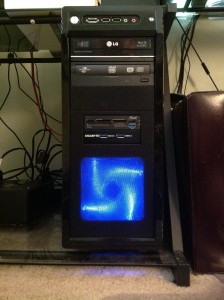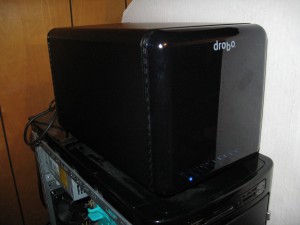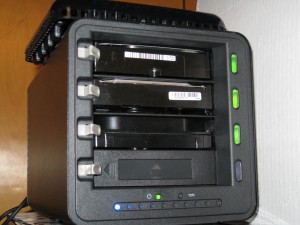I’ve been playing with computers since college in the 80’s. Fortran was the only programming language offered at W&J and we would sneak into the lab at night to play an ASCII based adventure game that was on the system’s four terminals. My first computer was a Commodore 64 and I used it mostly for games and played with the GEOS operating system. It had a GUI and all the features we’ve come to expect in a modern OS. In the early 1990’s I bought my first PC, an IBM with the then new Intel 486sx processor. It had 4 megabytes (not gigabytes) of RAM a 170MB hard drive, both 5.25 and 3.5 inch floppy drives and was capable of displaying 256 colors on its 13″ CRT. MS-DOS (5.0 Ithink) and Windows 3.1 were installed and it had a 2400 baud modem to connect to BBS systems. It came with a Prodigy trial account, but I soon joined Compuserve because it was where all the best computer and news groups were. Not able to leave things alone, I upgraded the RAM to 8mb at a cost of $50/mb, added an 8 bit sound card and bought a bunch of little video memory chips that plugged into the motherboard to give me 65,000 colors when playing games. Since it had a 486sx CPU and Intel came out with math co-processor chips to boost performance (actually just DX chips) and I even put in their DX-2 chip when available to double the clock speed. Since then I have built and upgraded systems for myself and learned all about ISA and VESA local bus, memory managers, IRQ conflicts, editing autoexec.bat/config.sys/win.ini/sys.ini files ad nauseum. Finally computer power grew to the point where the games and things I was doing didn’t require constant attention and upgrades. for the past 4 years or so, I was getting by with a refurbished HP 8120n. It had a quadcore Q6600 cpu and I only bumped up the RAM to 4GB and upgraded the videocard twice over the years. Being an HP system it didn’t have the parts I would have chosen, but it was a good deal at the time and it did yeoman service as I have said for 4 years. Well once I retired I thought I should build myself a new computer that will do anything I can think of now and for the next 4 or 5 years.
Sound and video editing are the biggest tasks my new machine may be asked to do. With smart phones and the iPad capable of making HD video, the home movie is getting quite the makeover and everyone seems to be putting their creations on Youtube, so why not me? I have time to play more games and I think I might try Skyrim or the latest in the Call of Duty franchise. These things can tax the CPU and the video subsystem to a great extent. I’ve always tried to get the best bang for my buck and this build is no different. My significant other has given me that look that means “I don’t understand it, but if it makes you happy, go ahead. Just don’t go too far overboard with it.” I could have worse vices, I suppose. After much research I came up with the spec’s and my choice of parts. Intel or AMD? Intel of course. AMD makes good low end CPU’s, but nothing they have can compare clock for clock with Intel.
Next decision was what socket, 2011 or 1155? 2011 is the newest and may have the longest projected lifespan, but there are only something like 3 current CPU’s for the socket and they cost from $300 to over $1000. Socket 1155 will be around for the next couple of generations of CPU’s I think and will take the latest Ivy Bridge parts today. So, it will be socket 1155, but what motherboard and CPU? Looked at MSI, Asrock and Gigagyte boards and they each have good boards and comparable features. I finally chose the Gigabyte Z77X-UD5H-WB due to it’s heavy duty PCB, dual gigabit LAN ports, plethora of USB 3.0, esata and SATA III ports. I got the version with a wi-fi/bluetooth add-in card because I need wi-fi to connect with our downstairs router to which all the network entertainment components (Onkyo Receiver, Roku, Blu-ray, home theater PC) are hardwired. I chose a middle of the road CPU, the Intel 3570K. It is a Core I-5 quadcore part that runs at 3.4Ghz. It is unlocked, so can be easily overclocked, if I choose to go there. It screams compared to the old Q6600 (and it was no slouch). I went with an aftermarket CPU cooler because the stock coolers are loud and keep the CPU from overheating, but just barely. The Cooler Master Hyper 212 plus is huge, but it’s big fan turns slower, cools much better and makes less noise. I have read people have overclocked this CPU to almost 5Ghz using this same cooler. A $10 rebate made it more attractive as well. To power the board and CPU I got a Corsair 700 watt modular power supply. Modular means only the connections I need are used and there are no unwanted power cables to keep out of the way(btw, it had a $30 rebate).
RAM is about as cheap as it has been for some time. I went overboard and maxed the board out with 32GB of DDR3 1600 from G.Skill. With that amount I can play with RAM disks and shouldn’t have to worry about page files and virtual memory. The Ivy Bridge CPU’s have Intel’s latest integrated HD 4000 graphics. This is much better than the 3000 and 2500 of previous Sandy Bridge and earlier CPU’s. However, they cannot compete with a discreet add-in video card. Again, I went middle of the road and got an AMD Radeon HD7770 Gigahertz Edition made by Sapphire ($15 rebate). With my BenQ 24″ monitor, it will drive all the games I like at the highest detail levels. Graphics cards are the easiest thing to upgrade and about the only thing I might over the next few years. Internal storage is handled by a 240GB Corsair SSD ($30 rebate) and an older 256GB Samsung SSD I got from a geek on Craigslist for $100 when he wanted a bigger SSD. Once you go SSD, you’ll never want to go back to waiting for that spinning hard drive to read and load the operating system on boot. For data and internal backup I have two 1TB drives in a RAID 1 mirror.
All this is stuffed in an inexpensive Rosewill Challenger case. I added an LG Blu-ray reader/DVD burner and another DVD burner I had lying around just in case I want to copy and burn at the same time. The build went pretty smoothly. I suggest adding as many components as you can before mounting the motherboard into the case. Once in, things get cramped and my short stubby fingers have a hard time plugging things in. Installing Windows 7 Ultimate was easy and restoring my data from the Drobo held no surprises. I’m still tweaking settings and deciding what programs I really use and not installing things I don’t need. This is fun for me. Some folks like to plant flowers. Let’s see how long I can go before the adding something new. Please share your computer stories, I’d love to hear them good or bad.


